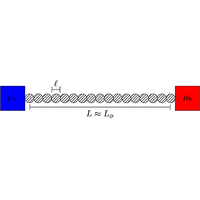Abstract
Quantum coherences characterize the ability of particles to quantum mechanically interfere within some given distances. In the context of noisy many-body quantum systems, these coherences can fluctuate. A simple toy model to study such fluctuations in an out-of-equilibrium setting is the open quantum symmetric simple exclusion process (Q-SSEP), which describes spinless fermions in one dimension hopping to neighboring sites with random amplitudes coupled between two reservoirs. Here, we show that the dynamics of fluctuations of coherences in Q-SSEP have a natural interpretation as free cumulants, a concept from free probability theory. Based on this insight, we provide heuristic arguments as to why we expect free probability theory to be an appropriate framework to describe coherent fluctuations in generic mesoscopic systems where the noise emerges from a coarse-grained description. In the case of Q-SSEP, we show how the link to free probability theory can be used to derive the time evolution of connected fluctuations of coherences as well as a simple steady-state solution.
- Received 5 May 2022
- Revised 5 December 2022
- Accepted 17 January 2023
DOI:https://doi.org/10.1103/PhysRevX.13.011045
Published by the American Physical Society under the terms of the Creative Commons Attribution 4.0 International license. Further distribution of this work must maintain attribution to the author(s) and the published article’s title, journal citation, and DOI.
Published by the American Physical Society
Physics Subject Headings (PhySH)
Popular Summary
The characterization of nonequilibrium systems from the point of view of statistical mechanics is an enduring challenge in theoretical physics. Since such systems usually depend on a variety of system-specific details, there are no general formulas for the probability of microscopic configurations. Usually, one is interested in the statistics of measurable, macroscopic quantities such as the particle density or current. However, if the size of such systems is very small, quantum mechanical effects can become important, and they can affect macroscopic quantities. Here, we show that the fluctuations of these quantum mechanical effects have a universal description that applies to generic mesoscopic and diffusive systems.
We study a toy mathematical model that provides the minimal structure necessary to describe the fluctuations of quantum mechanical effects in diffusive, nonequilibrium, many-body quantum systems. We show that these fluctuations have a natural mathematical description in terms of tools from free probability theory, a framework that deals with noncommuting random variables—a feature also central to quantum mechanics. Furthermore, we argue why we expect this connection to hold for generic mesoscopic systems, and we interpret the emergence of free probability theory in our toy model as a sign that the model could indeed encode universal fluctuations of a larger class of systems.
Free probability has also been observed in the context of the eigenstate thermalization hypothesis—a set of ideas to explain why an isolated quantum mechanical system can be described using equilibrium statistical mechanics—and we expect that its tools will play an important role in the understanding of chaotic or noisy many-body quantum systems.



